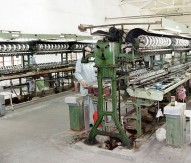

Dr Andreas Schmidt
SMEs feel the pinch in textile sector
The textile and clothing manufacturing sector is one of the largest employers in Europe. The industry is dominated by SMEs, accounting for more than 90% of the workforce. Major European producers include Italy, the UK and Germany.
Dr Andreas Schmidt is the director of function and care at the Hohenstein Institute, a laboratory specialising in applied textile research and testing. He says that reduced funding from Horizon 2020 could mean a missed opportunity for European collaborative RDI, with companies readjusting their focus to national funding opportunities and the largest firms receiving the most support.
With Horizon 2020 now expected to receive a 12% reduction in funding compared to the European Commission’s original proposal, what effect do you think this will have on RDI in the textile industry?
When I heard this for the first time, I was very concerned. Horizon 2020 funding will be a key source of R&D funding and I think we have a great opportunity to undertake promising research in the textile industry, but this is now more difficult to achieve.
In my opinion, this financial reduction will lead to two key consequences. The first is that fewer projects will be funded. The success rate for European project proposals is always very low because a lot of companies and institutes are applying for funding. Now there is even less money available, even fewer projects will be possible.
The second consequence is regarding product development. In the long-term, companies will now more than likely decide to develop ideas by themselves. This is likely to lead to increased internal company development and knowledge, as demonstrated in the USA.
Some European companies may also look to self-financing projects. Overall, although this will ensure there is less collaboration and less knowledge sharing in Europe – R&D knowledge is not spread within the community. The strongest companies will survive and the smallest companies, many of which are very innovative, can struggle to invest and compete.
So, in conclusion, fewer projects will be funded and there will be a reduced spread of knowledge within the textile industry.
To what extent is a simplification of rules and funding rates likely to encourage greater participation in Horizon 2020?
The funding ratios are much better under Horizon 2020 compared to FP7. This will really encourage companies and institutes to develop a Horizon 2020 project. With a 12% reduction in funding though, this is a real issue. Funding will be easier to apply for, but there is less money to obtain.
In Germany, there are some excellent financial opportunities compared to the EU, yet European projects often have more money available. One major difference, however, between national and supranational projects is language – EU applications are often done in another language and this can sometimes be an issue. EU projects are also more focused on international collaboration – you have to know and have to develop a close relationship with foreign companies and institutes, in advance, in order to present a good project proposal and to have a real chance of obtaining funding.
Germany is comparable to the UK, where you have a national research funding system and a common language – it’s quite easy to make an application. As soon as you cross the border to the European community, it becomes increasingly difficult.
Overall, the change in EU rules and funding rates is a good move that will encourage greater participation, but reduced funding is disappointing. We’ll have to see how many projects are finally funded.
A major focus of Horizon 2020 will be to bring new products to market. What results do you think we could expect from Horizon 2020?
I expect many new products will be funded by Horizon 2020. We see Horizon 2020 as a really important development – after all, this is what a company wants! Companies, and particularly SMEs, want to sell products. SMEs are not really interested in basic research but more in applied research – they need to make money to survive and making profit is gained through new goods and services.
As discussed earlier, it will be easier to apply for Horizon 2020 funding. FP7 didn’t really address this issue – it was more focused on developing prototypes. This is a great step forward and something that will encourage greater participation in Horizon 2020.
How likely will you be applying for Horizon 2020 funding?
We will be applying for Horizon 2020 funding with some other institutes in the EU. If you apply for European funding, it’s always better to have two or three entities working together as you are then more likely to receive funding.
Dr Andreas Schmidt



